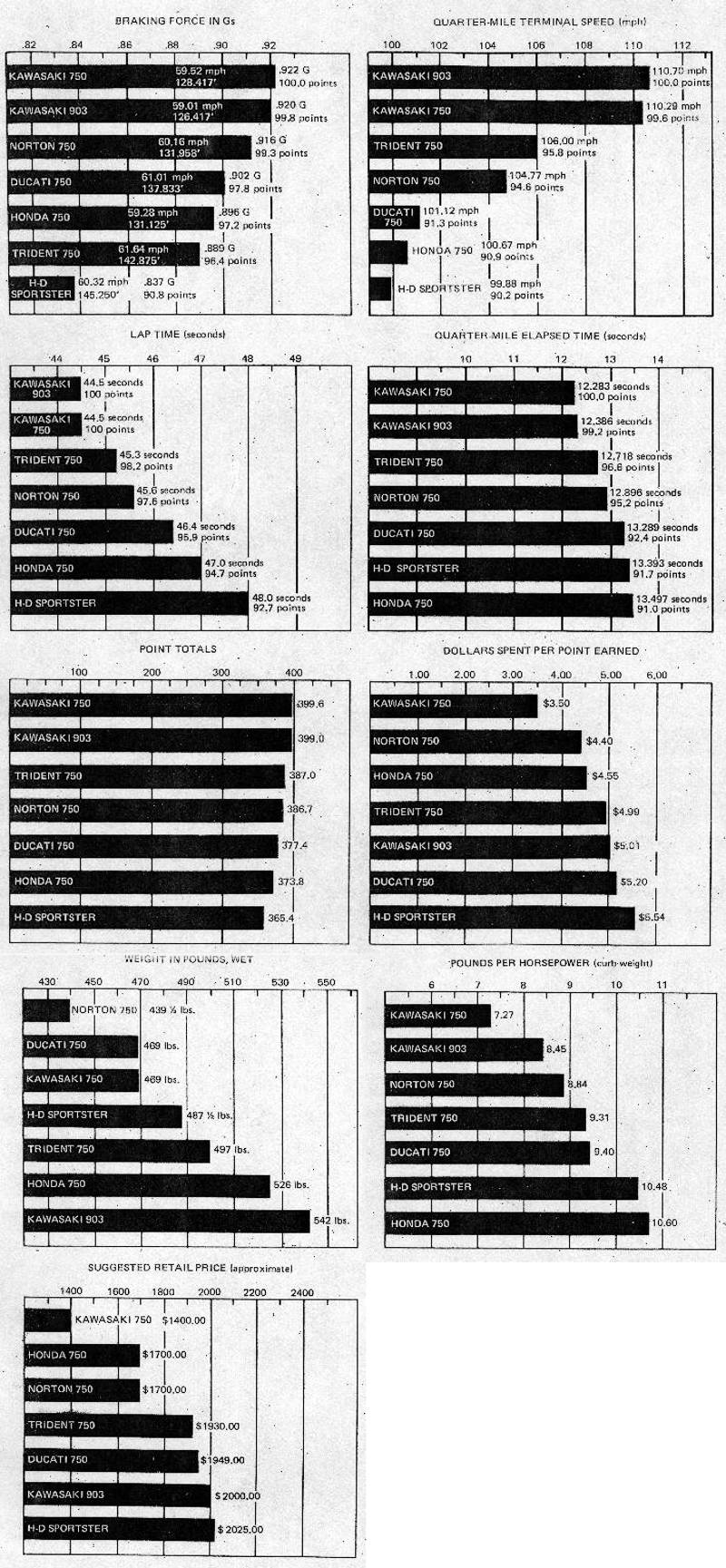
CHECK WITH US IN TWO YEARS
Which left us with an empty shop, for the first time in more than a month.
For a month it had held the finest (and the only) collection of late model
maximum-performance motorcycles ever assembled. Imagine it; not one but two
stock bikes capable of 110mph standing-start quarter-miles. Seven motorcycles,
all with disc front brakes, all with their own tuners, all as good as they
possibly could have been. They had been
stripped of all conceivable excuses for indifferent performance—and most of them
had performed well. Yamaha’s dynamometer revealed hogwash-free engine
performance data; the braking test had revealed the truth about stopping
performance the drag strip had revealed the truth about acceleration
performance; and the circuit had revealed the truth about handling performance
and how well the suspension, brakes and engine worked in concert.
What had we learned? A lot of specific, numerical, passionless facts all of which have been laid out for you; and a few, less specific, less empirical, more subjective gut feelings that we didn’t have before the test started. Item: the Ducati and the Honda are a lot better than the point totals suggest, and so is the 903, even though it finished an eye-lash behind the Mach IV; item: that it is going to be critically important for you to understand that raw performance, though readily measured and quantified, is not the most important consideration when you’re trying to decide which of the Superbikes has the most appeal to you.
Which might come as a surprise to you—it certainly did to us. Superbikes are changing. Two years ago it seemed to make sense that if you wanted max performance, you should be willing to make some sacrifices. It doesn’t make any sense now, because the best bikes in the test have trade off a couple of tenths and a few miles-per-hour for reliability, civility, and longevity, and the trade has made them better motorcycles. The Superbike era as we knew it in 1970 is gone. The new Superbike era—which has not as yet fully developed—will see this year’s hot-test performers toning down their blood-curdling performance and toning up their reliability, moving towards the Cadillac-land of the BMW; and it will see the BMWs and the Moto Guzzis going in the opposite direction, brightening their image for more broad-based sales appeal, moving towards Superbike-land. When the two meet and intermingle, it will be time again for another Superbike Comparison Test.
And that leaves this one, which we said at the outset is limited but it’s pure. If you’ve poured over the charts and graphs you know by now that the Kawasaki 750 delivered the test’s low ET, second-highest quarter-mile speed, the fastest lap time, the strongest braking force, the highest torque and horsepower readings on the dynamometer, the highest power-to-weight ratio, the lowest price, the fewest dollars spent per point earned, and the highest point total—399.6 against a perfect total of 400. Based on performance alone, it is without a question of doubt the King of the Superbikes. Right behind it, with a point total of 399.0, is the devastating 903cc Z1, which delivers nearly as much absolute performance as does the Mach IV and a bunch more on hand: If you read our November road test on the Z1, you must know by now that we have nothing more to say about it except that it could use—higher-quality shock absorbers and a disc rear brake.
Third was the Triumph Trident with 387 points, and fourth was the Norton Commando Roadster with 386.7. Both did extraordinarily well considering that neither was blessed with a surfeit of horsepower, and considering that both have been around in fundamentally the same form for a number of years.
In fifth spot was the Ducati 750, a motor-cycle as cruelly restricted by the test as either the Honda750 or the 903. The Duke earned 377.4 points by being close to the middle of every category. It was also the bike that everybody wanted to ride home, points total or no.
In sixth was the Honda 750 with 373.8 points, which we suppose is the price it has to pay for evolving so naturally into a splendid piece of equipment. The Honda does nothing wrong; throwing it into a Superbike Comparison Test, however, is like asking Mark Brelsford to participate in a water-polo tournament. He’ll do OK because he’s an athlete but it’s not what he does best.
And last is the Sportster with 365.4 points, shoving forth its image and hiding its performance figures. The Sportster and the Kawasaki 750 are the last two legitimate, old-time Superbikes; every other participant had evolved beyond the 1970 definition, and even the Mach IV shows signs of civility. The Sportster is to be praised for its noise control; but for a bike that demands the considerations that Superbikes used to be entitled to it delivers rather shoddy absolute performance, and what performance it does deliver comes at a pretty high price—the XLCH was the most expensive bike in the test. For every point earned, it charges $5.54. The Kawasaki only charges $3.50.
With a new Superbike era around the corner, will be new rules and performance parameters to consider, a new way of looking at the field, new sets of critical measurements to be taken. Honda, Norton, Kawasaki, Ducati and Triumph: they’re all telling us the same thing. Times are changing. Things are different. And we must respond with a new comparison test format, one that will evaluate, not simply performance, but all the things which are suddenly just as important. The field should be complete and ready in two years or so. We’ll be ready too, and we’ll be back. But for now a last, fond look at the Kawasaki Mach IV 750, the winner outright and ruler without question.
You might have thought it made up the rules. •
